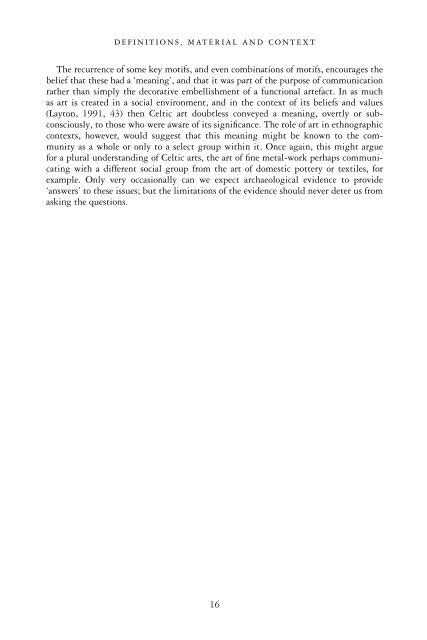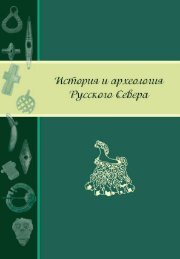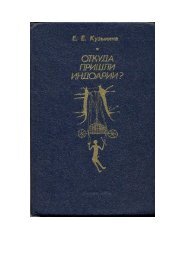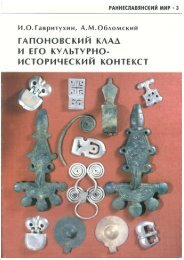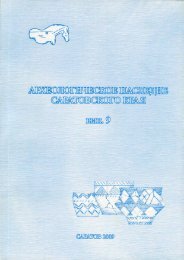- Page 2: THE ARCHAEOLOGY OF CELTIC ARTTemper
- Page 5 and 6: First published 2007by Routledge2 P
- Page 8: LIST OF COLOUR PLATES(The colour pl
- Page 11 and 12: LIST OF FIGURES4.11 Insular early L
- Page 14 and 15: PREFACEMy interest in Celtic art ar
- Page 16: PREFACEFinally, I should record my
- Page 19 and 20: DEFINITIONS, MATERIAL AND CONTEXTat
- Page 21 and 22: DEFINITIONS, MATERIAL AND CONTEXTca
- Page 23 and 24: DEFINITIONS, MATERIAL AND CONTEXTAp
- Page 25 and 26: DEFINITIONS, MATERIAL AND CONTEXTdi
- Page 27 and 28: DEFINITIONS, MATERIAL AND CONTEXTon
- Page 29 and 30: DEFINITIONS, MATERIAL AND CONTEXTth
- Page 31: DEFINITIONS, MATERIAL AND CONTEXTin
- Page 35 and 36: LATER BRONZE AGE AND HALLSTATT ORIG
- Page 37 and 38: LATER BRONZE AGE AND HALLSTATT ORIG
- Page 39 and 40: Figure 2.2 Late Bronze Age cult veh
- Page 41 and 42: LATER BRONZE AGE AND HALLSTATT ORIG
- Page 43 and 44: LATER BRONZE AGE AND HALLSTATT ORIG
- Page 45 and 46: Figure 2.5 The Urnfield warrior, eq
- Page 47 and 48: LATER BRONZE AGE AND HALLSTATT ORIG
- Page 49 and 50: LATER BRONZE AGE AND HALLSTATT ORIG
- Page 51 and 52: LATER BRONZE AGE AND HALLSTATT ORIG
- Page 53 and 54: LATER BRONZE AGE AND HALLSTATT ORIG
- Page 55 and 56: 3THE LA TÈNE EARLY STYLESOrigins a
- Page 57 and 58: THE LA TÈNE EARLY STYLESexamples a
- Page 59 and 60: THE LA TÈNE EARLY STYLESthat has a
- Page 61 and 62: THE LA TÈNE EARLY STYLESfrom the p
- Page 63 and 64: Figure 3.4 Engraved ornament on the
- Page 65 and 66: THE LA TÈNE EARLY STYLESdevised on
- Page 67 and 68: THE LA TÈNE EARLY STYLESFigure 3.5
- Page 69 and 70: Figure 3.6 Dürrnberg bei Hallein,
- Page 71 and 72: THE LA TÈNE EARLY STYLESfinger-rin
- Page 73 and 74: THE LA TÈNE EARLY STYLESFigure 3.8
- Page 75 and 76: THE LA TÈNE EARLY STYLESOrientaliz
- Page 77 and 78: Figure 3.10 Belt attachments from n
- Page 79 and 80: THE LA TÈNE EARLY STYLESand three
- Page 81 and 82: Figure 3.11 The Glauberg bronze tor
- Page 83 and 84:
THE LA TÈNE DEVELOPED STYLESFigure
- Page 85 and 86:
THE LA TÈNE DEVELOPED STYLESFigure
- Page 87 and 88:
THE LA TÈNE DEVELOPED STYLESdisint
- Page 89 and 90:
THE LA TÈNE DEVELOPED STYLESsince
- Page 91 and 92:
THE LA TÈNE DEVELOPED STYLESidenti
- Page 93 and 94:
THE LA TÈNE DEVELOPED STYLESWaldal
- Page 95 and 96:
Figure 4.7 Torcs and arm-ring from
- Page 97 and 98:
Figure 4.8 La Tène decorated potte
- Page 99 and 100:
Figure 4.9 Münsingen, Berne. A: ce
- Page 101 and 102:
THE LA TÈNE DEVELOPED STYLESon the
- Page 103 and 104:
Figure 4.11 Insular early La Tène
- Page 105 and 106:
THE LA TÈNE DEVELOPED STYLESvexing
- Page 107 and 108:
THE LA TÈNE DEVELOPED STYLESPrunay
- Page 109 and 110:
THE LA TÈNE DEVELOPED STYLESgroupi
- Page 111 and 112:
THE ART OF THE SWORDSMITHwhich spec
- Page 113 and 114:
THE ART OF THE SWORDSMITHstylized b
- Page 115 and 116:
THE ART OF THE SWORDSMITHFigure 5.2
- Page 117 and 118:
Figure 5.3 ‘Halimba’ scabbard f
- Page 119 and 120:
THE ART OF THE SWORDSMITHconservati
- Page 121 and 122:
THE ART OF THE SWORDSMITHAmeglia, c
- Page 123 and 124:
THE ART OF THE SWORDSMITHapart from
- Page 125 and 126:
Figure 5.7 Scabbards from eastern E
- Page 127 and 128:
THE ART OF THE SWORDSMITHtriangles
- Page 129 and 130:
THE ART OF THE SWORDSMITHtheme, an
- Page 131 and 132:
Figure 5.9 Irish engraved scabbards
- Page 133 and 134:
THE ART OF THE SWORDSMITHand freque
- Page 135 and 136:
6THE LA TÈNE LATERRELIEF STYLESBro
- Page 137 and 138:
Figure 6.1 La Tène ‘Plastic Styl
- Page 139 and 140:
THE LA TÈNE LATER RELIEF STYLEShem
- Page 141 and 142:
THE LA TÈNE LATER RELIEF STYLESA d
- Page 143 and 144:
THE LA TÈNE LATER RELIEF STYLESinh
- Page 145 and 146:
THE LA TÈNE LATER RELIEF STYLESin
- Page 147 and 148:
THE LA TÈNE LATER RELIEF STYLESwit
- Page 149 and 150:
THE LA TÈNE LATER RELIEF STYLESess
- Page 151 and 152:
THE LA TÈNE LATER RELIEF STYLESFig
- Page 153 and 154:
THE LA TÈNE LATER RELIEF STYLESpla
- Page 155 and 156:
Figure 6.10 British Iron Age brooch
- Page 157 and 158:
7INSULAR BRITISH ART TO THEROMAN CO
- Page 159 and 160:
INSULAR BRITISH ART TO THE ROMAN CO
- Page 161:
Figure 7.1 Engraved and relief orna
- Page 179 and 180:
INSULAR BRITISH ART TO THE ROMAN CO
- Page 181 and 182:
Figure 7.3 The Witham shield. Adapt
- Page 183 and 184:
INSULAR BRITISH ART TO THE ROMAN CO
- Page 185 and 186:
INSULAR BRITISH ART TO THE ROMAN CO
- Page 187 and 188:
INSULAR BRITISH ART TO THE ROMAN CO
- Page 189 and 190:
Figure 7.5 Iron Age decorated potte
- Page 191 and 192:
INSULAR BRITISH ART TO THE ROMAN CO
- Page 193 and 194:
Figure 7.7 Mirrors from Holcombe, D
- Page 195 and 196:
Figure 7.8 Mirror from Desborough,
- Page 197 and 198:
8LA TÈNE AND NON-LA TÈNEIN IRELAN
- Page 199 and 200:
LA TÈNE AND NON-LA TÈNE IN IRELAN
- Page 201 and 202:
LA TÈNE AND NON-LA TÈNE IN IRELAN
- Page 203 and 204:
Figure 8.3 Irish ‘La Tène’ - 1
- Page 205 and 206:
LA TÈNE AND NON-LA TÈNE IN IRELAN
- Page 207 and 208:
Figure 8.4 1. Knock (‘Clonmacnois
- Page 209 and 210:
Figure 8.5 Irish ‘La Tène’ - 2
- Page 211 and 212:
LA TÈNE AND NON-LA TÈNE IN IRELAN
- Page 213 and 214:
Figure 8.6 The Turoe stone, Co Galw
- Page 215 and 216:
Figure 8.7 Ireland and Northern Bri
- Page 217 and 218:
Figure 8.8 Ceremonial head-gear. A:
- Page 219 and 220:
Figure 8.9 Ornamented discs. A: Ban
- Page 221 and 222:
LA TÈNE AND NON-LA TÈNE IN IRELAN
- Page 223 and 224:
SOUTH-WEST EUROPE AND THE CELTIBERI
- Page 225 and 226:
SOUTH-WEST EUROPE AND THE CELTIBERI
- Page 227 and 228:
Figure 9.2 Anthropomorphic and zoom
- Page 229 and 230:
SOUTH-WEST EUROPE AND THE CELTIBERI
- Page 231 and 232:
Figure 9.4 Celto-Ligurian statuary.
- Page 233 and 234:
SOUTH-WEST EUROPE AND THE CELTIBERI
- Page 235 and 236:
Figure 9.6 Celtiberian swords and s
- Page 237 and 238:
SOUTH-WEST EUROPE AND THE CELTIBERI
- Page 239 and 240:
SOUTH-WEST EUROPE AND THE CELTIBERI
- Page 241 and 242:
SOUTH-WEST EUROPE AND THE CELTIBERI
- Page 243 and 244:
SOUTH-WEST EUROPE AND THE CELTIBERI
- Page 245 and 246:
LATER STYLES AND ROMANIZING INFLUEN
- Page 247 and 248:
LATER STYLES AND ROMANIZING INFLUEN
- Page 249 and 250:
LATER STYLES AND ROMANIZING INFLUEN
- Page 251 and 252:
LATER STYLES AND ROMANIZING INFLUEN
- Page 253 and 254:
LATER STYLES AND ROMANIZING INFLUEN
- Page 255 and 256:
LATER STYLES AND ROMANIZING INFLUEN
- Page 257 and 258:
LATER STYLES AND ROMANIZING INFLUEN
- Page 259 and 260:
LATER STYLES AND ROMANIZING INFLUEN
- Page 261 and 262:
LATER STYLES AND ROMANIZING INFLUEN
- Page 263 and 264:
LATER STYLES AND ROMANIZING INFLUEN
- Page 265 and 266:
LATER STYLES AND ROMANIZING INFLUEN
- Page 267 and 268:
LATER STYLES AND ROMANIZING INFLUEN
- Page 269 and 270:
Figure 10.10 Scottish cast bronze a
- Page 271 and 272:
11LATER INSULAR ART IN BRITAINAND I
- Page 273 and 274:
LATER INSULAR ART IN BRITAIN AND IR
- Page 275 and 276:
LATER INSULAR ART IN BRITAIN AND IR
- Page 277 and 278:
Figure 11.4 The Norrie’s Law, Fif
- Page 279 and 280:
LATER INSULAR ART IN BRITAIN AND IR
- Page 281 and 282:
LATER INSULAR ART IN BRITAIN AND IR
- Page 283 and 284:
LATER INSULAR ART IN BRITAIN AND IR
- Page 285 and 286:
LATER INSULAR ART IN BRITAIN AND IR
- Page 287 and 288:
LATER INSULAR ART IN BRITAIN AND IR
- Page 289 and 290:
LATER INSULAR ART IN BRITAIN AND IR
- Page 291 and 292:
LATER INSULAR ART IN BRITAIN AND IR
- Page 293 and 294:
Figure 11.10 Technical details of t
- Page 295 and 296:
12CONCLUSIONSArchaeology and Celtic
- Page 297 and 298:
CONCLUSIONSFirst, we should try to
- Page 299 and 300:
CONCLUSIONSOn the principle that th
- Page 301 and 302:
CONCLUSIONSDespite some recent rese
- Page 303 and 304:
CONCLUSIONSVehicle embellishments,
- Page 305 and 306:
CONCLUSIONSof the wearer. In the co
- Page 307 and 308:
CONCLUSIONS13). On the other hand,
- Page 309 and 310:
BIBLIOGRAPHYAllen, D. and Nash, D.
- Page 311 and 312:
BIBLIOGRAPHYColes, J. M. (1962) ‘
- Page 313 and 314:
BIBLIOGRAPHYFirth, R. (1951a) ‘Th
- Page 315 and 316:
BIBLIOGRAPHYHarding, D. W. and Gill
- Page 317 and 318:
BIBLIOGRAPHYKristiansen, K. and Jen
- Page 319 and 320:
BIBLIOGRAPHYNeedham, S. (1979) ‘T
- Page 321 and 322:
BIBLIOGRAPHYRyan, M. (1989) ‘Chur
- Page 323 and 324:
BIBLIOGRAPHYVillard-Le Tiec, A., Ch
- Page 325 and 326:
INDEXbeads: amber 45; ‘dumb-bell
- Page 327 and 328:
INDEXcrowns 153, 183-5, 184; see al
- Page 329 and 330:
INDEXHounslow 224, 265Hradenin 270,
- Page 331 and 332:
INDEX‘ornament horizon’ 173Orna
- Page 333 and 334:
INDEXsymbol stones, Class I 239, 24


